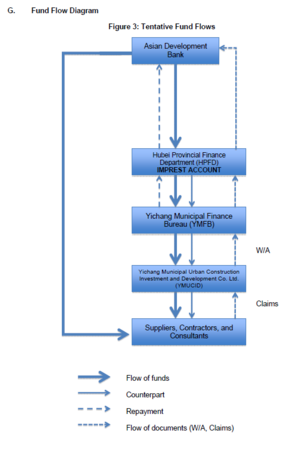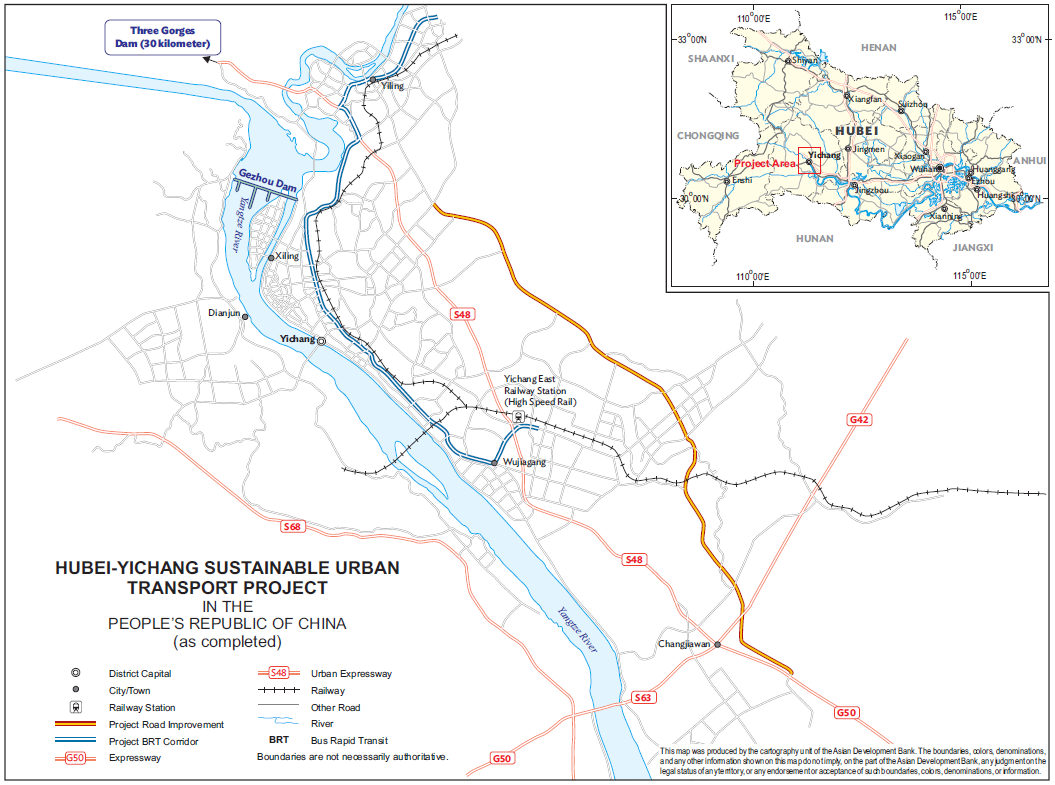Hubei-Yichang Sustainable Urban Transport Project: road network improvements for shipping bypass

Area: periurban
Date implemented: January 2017
How long from concept to implementation: 5 years
Relation between efforts undertaken and benefits achieved: good
What was done and how: A bypass road was built to redirect freight traffic away from the city centre and ease congestion. Yichang has a high volume of freight traffic from riverway shipping either bypassing the local dam's ship-lock capacity or moving on to destinations away from the river. This improves the capacity for waterway shipping, considered to be a mode sustainable logistics mode. More specifically, a 23.4 km extension of Dongshan 4th Road was built to accommodate through traffic and freight traffic, including pass-dam trans-shipment. The project comprises: (i) improvement of 12.3 km of the Fazhan Avenue–Bailinhe Road section to become a road width of 44-70 m; and (ii) improvement of the 11.1 km Bailinhe Road to Xianfeng Road section to become a Class 1 highway, with a road width of 24.5 m. Overall, this work includes 11 bridges and two tunnels. Funding was procured from municipal funds, a domestic state-owned bank (China Development Bank/Industrial and Commercial Bank of China), and a multilateral development bank (Asian Development Bank).
Why it worked to 'fast track' the innovation/measure: Top city leadership was directly involved in the implementation of the project and fully supported it. City leadership ensured that inter-agency coordination went smoothly. A special institutional setup was used to manage the project: a leading group, with its own headquarters and a Deputy Mayor in charge, was responsible for managing all other players in the project and liaising with funders to ensure implementation was in line with requirements.
Lessons learnt: A comprehensive study prior to planning enabled swift action to address the needs of the city, informed the project design, and helped convince shareholders through evidence-led planning. Strategic low-cost options along major arteries can bring more value than extensive road building to accomodate personal transport options. Holistic interventions adressing several issues increase the impact of each single measure.
Tips for replication: Engage in policy dialogue with potential funders: Yichang changed the proposal from one focused on road building within the city to one based on a BRT system and bypass after dialogue with the Asian Development Bank. Focus on a wholistic approach using several interlocked measures to tackle the issue. Comission exhaustive geological and ground surveys before construction to avoid delays during construction.
Sources or links:
- https://development.asia/case-study/optimizing-road-use-congested-city
- https://www.adb.org/projects/45023-002/main
- https://www.itdp.org/city-transformations/yichang/
- https://www.eltis.org/discover/case-studies/yichangs-holistic-award-winning-approach-sustainable-transport-china

Date implemented: January 2017
How long from concept to implementation: 5 years
Relation between efforts undertaken and benefits achieved: good
What was done and how: A bypass road was built to redirect freight traffic away from the city centre and ease congestion. Yichang has a high volume of freight traffic from riverway shipping either bypassing the local dam's ship-lock capacity or moving on to destinations away from the river. This improves the capacity for waterway shipping, considered to be a mode sustainable logistics mode. More specifically, a 23.4 km extension of Dongshan 4th Road was built to accommodate through traffic and freight traffic, including pass-dam trans-shipment. The project comprises: (i) improvement of 12.3 km of the Fazhan Avenue–Bailinhe Road section to become a road width of 44-70 m; and (ii) improvement of the 11.1 km Bailinhe Road to Xianfeng Road section to become a Class 1 highway, with a road width of 24.5 m. Overall, this work includes 11 bridges and two tunnels. Funding was procured from municipal funds, a domestic state-owned bank (China Development Bank/Industrial and Commercial Bank of China), and a multilateral development bank (Asian Development Bank).
Why it worked to 'fast track' the innovation/measure: Top city leadership was directly involved in the implementation of the project and fully supported it. City leadership ensured that inter-agency coordination went smoothly. A special institutional setup was used to manage the project: a leading group, with its own headquarters and a Deputy Mayor in charge, was responsible for managing all other players in the project and liaising with funders to ensure implementation was in line with requirements.
Lessons learnt: A comprehensive study prior to planning enabled swift action to address the needs of the city, informed the project design, and helped convince shareholders through evidence-led planning. Strategic low-cost options along major arteries can bring more value than extensive road building to accomodate personal transport options. Holistic interventions adressing several issues increase the impact of each single measure.
Tips for replication: Engage in policy dialogue with potential funders: Yichang changed the proposal from one focused on road building within the city to one based on a BRT system and bypass after dialogue with the Asian Development Bank. Focus on a wholistic approach using several interlocked measures to tackle the issue. Comission exhaustive geological and ground surveys before construction to avoid delays during construction.
Sources or links:







